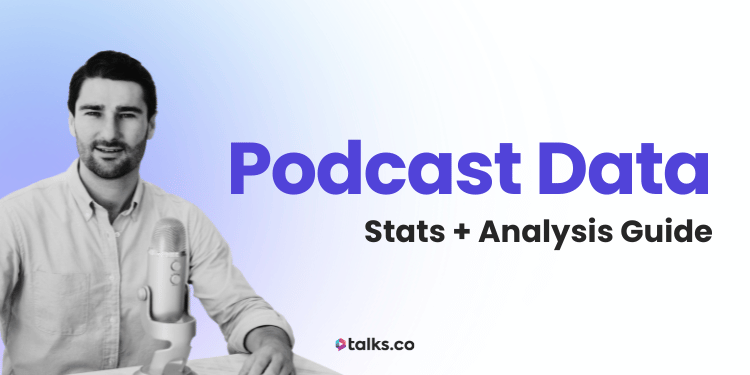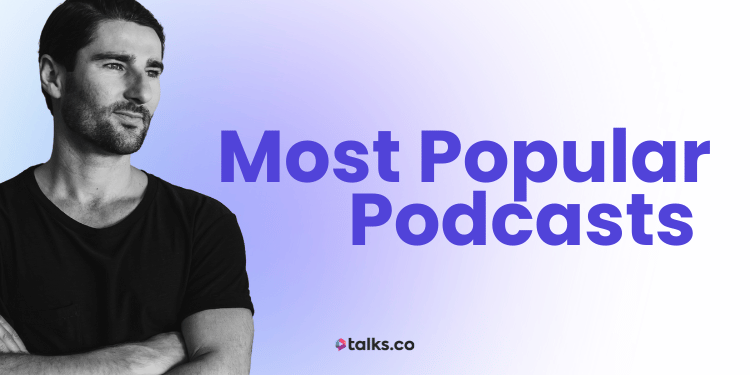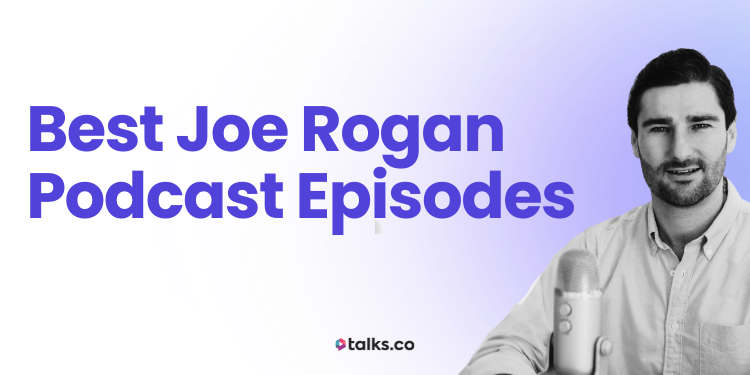Numbers don’t lie, and podcast data says that this platform is here to stay.
Is the podcasting industry thriving? How many people are actually listening? What should you do to grow?
All these questions can be answered by looking at key metrics and statistical figures. After all, that’s how you reveal who is listening, how they engage, and how you can expand your reach in a meaningful way.
If you’re curious how to turn podcast stats into smarter decisions, this guide will walk you through everything from the basics of data tracking to insights on listener behavior and industry trends.
I’ve also listed some key metrics you should start measuring, plus popular podcast recommendations that can inspire your journey.
Whether you’re new to podcasting or a seasoned host, this information will be helpful as you build your podcast empire.
What Is Podcast Data Analysis?

Podcast data analysis means looking at all the numbers and details that show how your podcast is doing. It’s about watching key podcast metrics to see what works and what needs improving.
Here are some important metrics to track:
- Podcast downloads: How many times your episodes are saved offline or streamed.
- Number of listeners: Unique people tuning in to your episode.
- Podcast listener demographics: Who your audience is by age, gender, location, and interests.
- Listener behavior: How long people listen and whether they finish episodes.
- Audience engagement: Shares, comments, reviews, and ratings of your show.
- Podcast ad metrics: How effective your podcast advertising is, like ad impressions and click-throughs.
- Podcast discoverability stats: How new listeners find your show.
Tracking these numbers matters because it helps you refine content, boost audience engagement, and improve monetization choices.
When you understand your data, you can create episodes that attract many listeners and turn podcast fans into loyal supporters.
When is data collected?

Podcast data is collected continuously as listeners play or download episodes. Platforms like Apple Podcasts Connect, Spotify for Podcasters, and third-party tools gather this data in near real-time.
Podcast hosts and producers can also use hosting services’ built-in analytics dashboards or advanced software like CoHost to see detailed insights (e.g., how many listeners a podcast has). These tools track listening from different devices and apps, giving a full picture of your audience’s habits.
What Is a Podcast vs Vodcast?
A podcast is an audio-only show that anyone can listen to, anytime. Meanwhile, a vodcast or video podcast includes video with the audio content, making it more like a recorded TV show.
While podcasts rely on people wanting to listen to podcasts during activities like commuting or working out, vodcasts attract viewers who prefer visual content.
How a podcast works
Podcasts are made by recording conversations, interviews, or storytelling, then uploading the audio files to a hosting platform. That platform distributes episodes to popular podcast directories like Spotify and Apple Podcasts, where listeners can download or stream them.
Listeners subscribe to shows, receive notifications for new episodes, and use podcast listening apps or smart devices to play content on demand.
Why a podcast is important for businesses
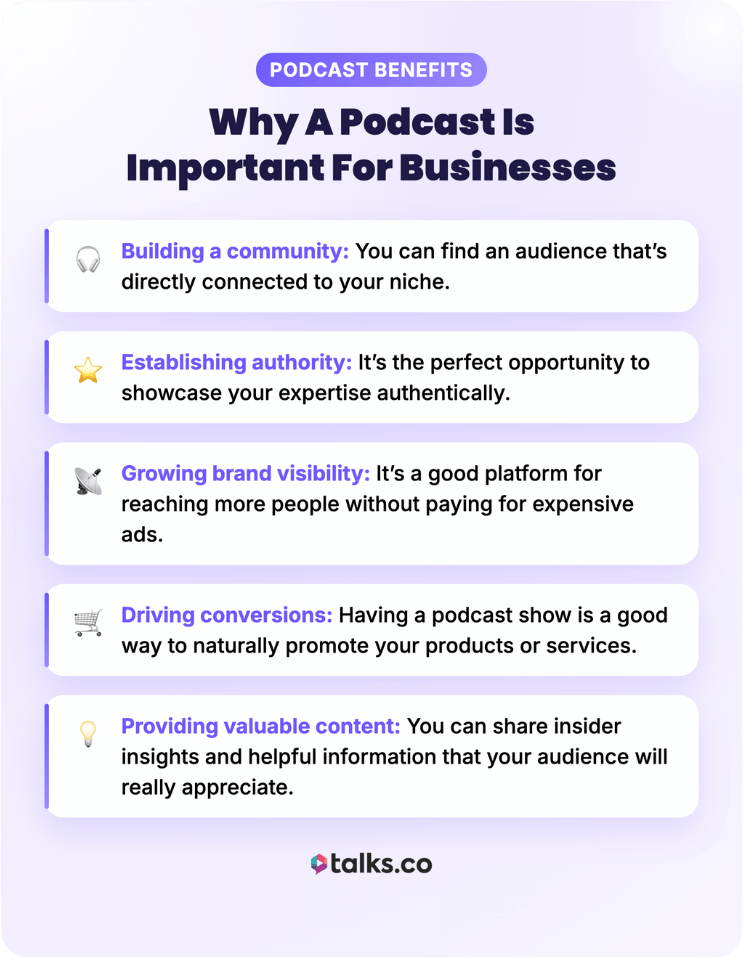
Thinking of starting your own podcast? Here’s how podcasts can do wonders for businesses and personalities:
- Building a community: You can find an audience that’s directly connected to your niche.
- Establishing authority: It’s the perfect opportunity to showcase your expertise authentically.
- Growing brand visibility: It’s a good platform for reaching more people without paying for expensive ads.
- Driving conversions: Having a podcast show is a good way to naturally promote your products or services.
- Providing valuable content: You can share insider insights and helpful information that your audience will really appreciate.
General Podcast Statistics
Looking at data isn’t exactly the hottest part of podcasting. But these numbers are the key to growing your podcast.
Podcast stats give you insight into trends and behavior that can show you the best path forward. From improving your content to making the most of opportunities, they help you make informed decisions.
Here are some key podcast statistics you should know:
Podcast audience data (demographics)
There are over 584.1 million podcast listeners worldwide, showing how much this industry thrives (eMarketer, 2025). Other key audience stats include:
- Age range: Most podcast listeners in the U.S. are aged 25-44, with a growing number of listeners aged 55 and older (Triton Rankers, 2025).
- Affluent listeners: Executives, managers and business owners who listen to podcasts engage longer and act on recommendations. 62% of them made a purchase based on a single host-read ad (Backlinko, 2025).
- Slightly male majority: More men listen to podcasts at 57%, with only a small margin of difference between women at 52% (Edison Research, 2025).
For more general podcast industry stats, check this guide.
Podcast listener data (behavior and trends)
Let’s take a closer look at how listeners of today behave. Here are some podcast listener statistics and trends that you can learn from:
- Average listening sessions: Most listeners tune in for about 30 to 40 minutes, finishing 70% of the episode content (FasterCapital, 2025).
- Follower loyalty: People who subscribed to your show consume four times the number of episodes vs. casual listeners (Spotify, 2024).
- Binge-listening: 60% of listeners find it easier to complete mini-series or seasonal podcasts (Podcast Trends Report, 2024).
Podcast episode data (trends, discover, performance)
Podcast episodes perform differently. Here are some key things to note about podcast discovery and performance:
- New podcast discovery: 50% of people discover new shows via charts and recommendations from their podcast app (The Podcast Host, 2024).
- Niche podcast performance: Niche genres = significant ROI lift. For example, finance and B2B podcasts generate leads up to 2.7x higher ROI (Acast, 2025).
- Top podcast platforms: 33% of weekly US listeners use YouTube for their podcasts (Edison Research).
- Device for podcast consumption: Smartphones are the main podcast listening device of about 70% of US weekly audiences (Cumulus Media).
Podcast production statistics
Producing a podcast can take about four to six hours per episode, including recording, editing, and publishing. Here are other podcast production statistics to take note of:
- Publishing schedule: 30% of podcasts launch episodes weekly (Podcast Insights).
- Frequency: Just 7% of shows release episodes every 0-2 days (Oberlo, 2024).
- AI tools: 57% of podcast hosts leverage AI-powered software for recording, editing, and marketing their shows (Market.Us, 2024).
Podcast monetization statistics
There are many ways you can monetize your podcast. For example, there are sponsorships, podcast advertising, donations, affiliate marketing, and premium content.
Make sure you’re making good decisions when monetizing by referring to the statistical data:
- Purchase decision: 46% of weekly podcast listeners converted after they listened to a podcast ad (Edison Research, 2024).
- Ad type: 55% of podcasting ad revenue comes from host-read ads (IAB).
- Podcast advertising influence: Podcast consumers are twice as likely to purchase products recommended on a podcast vs. other media consumers (Nielsen).
- Podcast ad spend: In the US, podcasting ad spend reached over $2.55 billion in 2025, growing by about 12% year-over-year (eMarketer, 2025).
- Alternative revenue: 25% of podcasters also gain income from live events, merchandise, and subscriber donations (Podnews, 2024).
- Memberships: 32% of podcast audiences opt for subscription and other paid community services. (Podnews, 2024).
Video podcast statistics
Video podcasts are the new norm. These figures point out that the format is here to stay and worth considering pivoting to:
- Video podcast audience: 51% of Americans over the age of 12 have watched a podcast (Edison Research, 2025).
- Spotify audience: Just on Spotify, over 270 million users have watched a video podcast (Spotify).
- Gen Z preferences: 84% of Gen Z audiences like to watch their podcasts more (Analyzify).
What Are the Most Popular Podcasts?
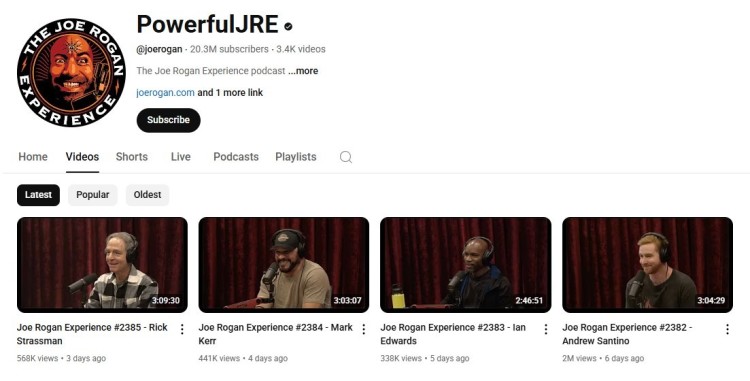
The most popular podcast genre in 2025 is comedy, with 30% of listeners tuned in (Spotify, Statista). Other beloved show categories are true crime, news and politics, business, comedy and health and wellness.
When it’s about specific podcast shows, those topping the charts are:
- The Joe Rogan Experience: Features long-form interviews with a candid and authentic feel.
- Crime Junkie: Known for gripping true crime storytelling that keeps listeners on the edge of their seats.
- The Daily: Helpful daily news briefings from The New York Times.
- Call Her Daddy: Relationship and lifestyle conversations full of drama and real-talk.
Most popular podcast directories
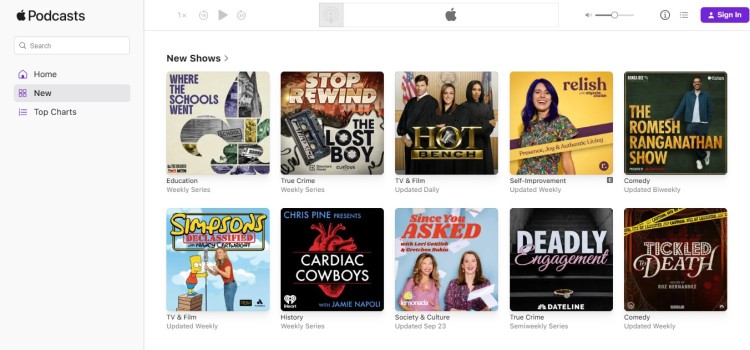
Recorded and edited your show? Great. Time for a podcasting directory or hosting platform to completely launch your podcast show:
- Apple Podcasts: The largest and oldest directory with strong analytics through Apple Podcasts Connect.
- Spotify: Fast-growing platform with detailed podcast analytics and personalized recommendations.
- Google Podcasts: A podcast platform that’s integrated with Android and Google Search.
- Amazon Music: This is quickly gaining traction for serving music and podcast combos.
Why a podcast is popular
More and more people are tuning in to podcasts, making them a daily companion when you commute or run errands. Here are some top reasons why podcasts are popular:
- Convenient: You can access content on demand, wherever you are in the world.
- Intimate connection: There’s something about being in someone’s ear that creates a close bond between you as the host and your listeners.
- Wide variety of topics: Podcast episodes are very diverse and can suit different people’s interests.
- Ability to multitask: People can listen to podcasts in the background as they complete other things.
- Trust in authentic, unfiltered voices: You can feature ideas and personalities that didn’t have the chance to do so in mainstream media. More perspectives, more voices.
How Many Podcasts Are There?
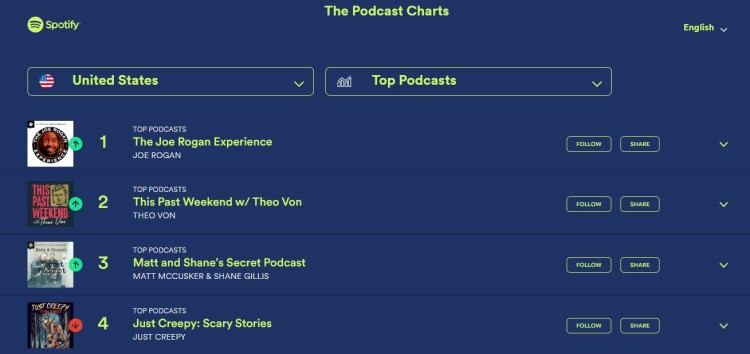
As of 2025, there are over 4.6 million podcast titles available worldwide, with new podcasts launched every day (Podcast Index, 2025).
- Monthly releases: About 320K new podcasts have been launched recently (Podcast Index, 2025).
- Language: Most podcasts (70%) are produced in English. Other popular languages are Spanish, Portuguese and German (Podcast Index, 2025).
- Spotify listing: As of September 2025, there are 7 million podcasts listed on Spotify (Spotify).
- Apple Podcast listing: Over 2.8 million podcasts are listed on Apple Podcasts as of April 2025 (Apple Podcasts).
Average number of podcast episodes
The number of podcast episodes produced varies greatly, depending on format and style. Over 56.1% of podcasts have fewer than 10 episodes, while only 17% have more than 50 (Research Gate).
When it comes to the different types of podcasts, here’s how many episodes they produce annually:
- Weekly podcasts: 50+ episodes per year
- Monthly podcasts: 12 episodes per year
- Limited-series or mini podcasts: 6-10 episodes
How often should you do a podcast
The ideal frequency is based on your goals and resources. Weekly shows tend to build podcast growth and audience engagement faster, but monthly podcasts work well for busy professionals.
BuzzSprout sheds light on the frequency of new episodes being published:
| Frequency | Percentage of episodes being published |
| Every 0 to 2 days | 6% |
| Every 3 to 7 days | 34% |
| Every 8 to 14 days | 39% |
| Every 15 to 29 days | 19% |
| Over 30 days | 1% |
Remember: Consistency is key. Regular publishing keeps your audience coming back and helps improve podcast discoverability.
How Do People Listen to Podcasts
People can listen to podcasts even when they’re doing something else. A YouGov survey reveals that these are the activities people do while tuning in:
- 49% of respondents complete their chores
- 42% of respondents listen while commuting to work
- 29% of respondents listen while working out
Keep these in mind when you’re brainstorming ideas for your next episode.
How many downloads does a podcast have
Download numbers are one sure way of measuring podcast success. With more and more interesting shows being launched, there were over 103.31 million downloads recorded by Buzzsprout (2024).
Here are other interesting podcast download statistics:
- Most downloads based on platform: 70.8% of podcast downloads were recorded from Apple Podcasts (Backlinko).
- Download performance: The top 1% of podcasts are downloaded an average of 4,824 times in the first seven days (BuzzSprout).
What Are Good Podcast Questions
One great podcast format to explore is an interview. You’re digging deep, trying to uncover authentic stories and valuable information.
To do that, here are some good podcast interview questions that you can ask your guest:
- What inspired you to start your journey?
- How do you overcome challenges in your field?
- Can you share a moment that changed everything for you?
- What advice would you give to someone starting out?
- How do you see your industry evolving in the next five years?
Podcast format ideas
Looking at the leading podcast formats, here are some popular ones you can try your hand at:
- Interview-based: You chat with your guest as they share their expertise and personal stories.
- Solo episodes: You record yourself as you talk about a particular topic.
- Panel discussions: You invite multiple guests to discuss a common subject or go around and share their opinions.
- Narrative storytelling: You create serialized stories or documentaries.
- Q&A episodes: You collect and then respond to listener questions.
Your Next Step Is Here
Podcast data can be your superpower. Track key metrics from listener behavior to episode performance so you can keep growing your show.
But strategic decisions are just one of the ways you can scale. What’s your next step?
That’s simple. Grow your podcast from within. Put out valuable content that will organically attract audiences. Invite experts and personalities to hop on your podcast. Interview them to unlock their stories and knowledge.
With Talks, finding guests who add value to your show is just a few clicks away. Create your Creators profile and the algorithm searches for you.
No endless scrolling through social media. No spammy emails. Just quality matches that spark good conversation.
Sign Up for a Free Talks Creator Profile Today.
